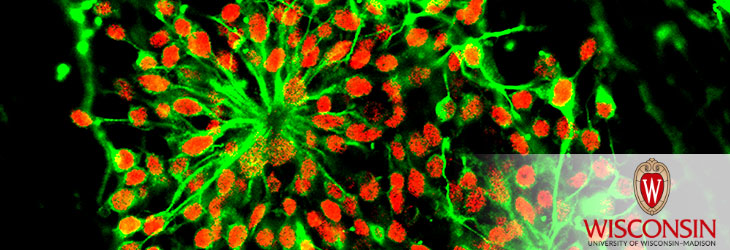Pluripotent Stem Cells

Peptide-Presenting Surfaces for Culturing Pluripotent Cells
WARF: P08404US02
Inventors: Laura Kiessling, Joseph Klim, Lingyin Li
The Wisconsin Alumni Research Foundation (WARF) is seeking commercial partners interested in developing chemically defined surfaces for the long-term growth and maintenance of pluripotent cells.
Overview
To leverage the phenomenal potential of pluripotent cells, either embryonic or induced, it is critical to develop standardized culture conditions free of animal products or serum, which tend to vary from batch to batch. Of particular interest are culture surfaces, as the cells require adhesion/attachment to a surface to maintain their remarkable properties.
While chemically defined (i.e., synthetic) surfaces for pluripotent cells have been developed, they have not proven effective for the cells’ long-term growth and self-renewal. Specifically, cells grown on these surfaces for several weeks form mixed populations of differentiated and undifferentiated cells, which can be challenging to separate. Also, these surfaces often rely on animal-derived components.
While chemically defined (i.e., synthetic) surfaces for pluripotent cells have been developed, they have not proven effective for the cells’ long-term growth and self-renewal. Specifically, cells grown on these surfaces for several weeks form mixed populations of differentiated and undifferentiated cells, which can be challenging to separate. Also, these surfaces often rely on animal-derived components.
The Invention
UW–Madison researchers have developed a chemically defined, animal-free surface for culturing pluripotent cells. The surface is an insoluble substrate containing a peptide that binds to the cells and supports adhesion. More specifically, the peptide binds to a type of carbohydrate in the cells called glycosaminoglycan (GAG).
The researchers observed that pluripotent cells have surface receptors that recognize and adhere to GAG-binding peptides. They realized that the binding peptides could be displayed on a surface as a synthetic alternative to extracellular matrix proteins such as those in Matrigel®.
Furthermore, the new surfaces can be made to display combinations of adhesive ligands/epitopes with control over density, location and composition.
The researchers observed that pluripotent cells have surface receptors that recognize and adhere to GAG-binding peptides. They realized that the binding peptides could be displayed on a surface as a synthetic alternative to extracellular matrix proteins such as those in Matrigel®.
Furthermore, the new surfaces can be made to display combinations of adhesive ligands/epitopes with control over density, location and composition.
Applications
- Peptide-presenting surfaces for culturing pluripotent cells
Key Benefits
- Chemically defined
- Minimizes exposure to hazardous contaminants and/or animal products
- Allows exquisite control over cell adhesion and fate
- Even after long-term culture (3+ months), cells retain:
- Normal karyotype
- Pluripotent cell-specific markers
- Ability to differentiate into all three germ layers
Additional Information
Related Technologies
Related Intellectual Property
Tech Fields
For current licensing status, please contact Andy DeTienne at [javascript protected email address] or 608-960-9857